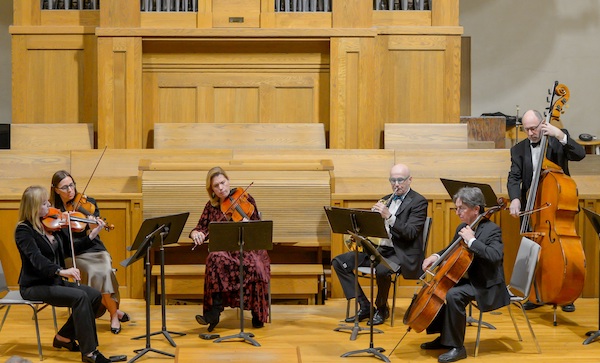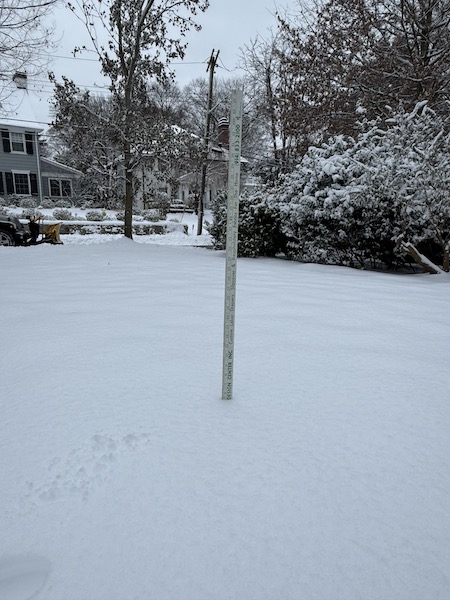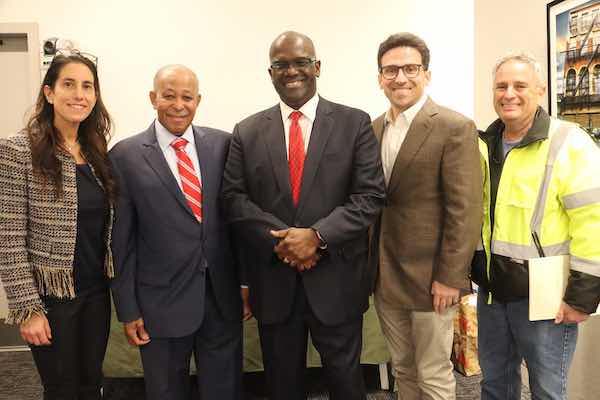Board Reviews Next Year's Calendar, the Future of the A School Building and Register Now for Kindergarten
- Details
- Written by: Wendy MacMillan
- Hits: 798
 Board of Education President, James Dugan, started the BOE meeting on Monday night with the reminder that the district’s proposed capital bond is the result of a months-long, transparent planning process and not a sudden proposal. He encouraged residents to review the extensive bond materials available on the district’s website, noting that while the information is substantial, it reflects careful consideration of the district’s long-term needs.
Board of Education President, James Dugan, started the BOE meeting on Monday night with the reminder that the district’s proposed capital bond is the result of a months-long, transparent planning process and not a sudden proposal. He encouraged residents to review the extensive bond materials available on the district’s website, noting that while the information is substantial, it reflects careful consideration of the district’s long-term needs.
Reflecting on Scarsdale’s more than 240-year commitment to public education, he said the community has consistently invested in its schools, helping establish a nationally recognized district known for academic excellence, including National Blue Ribbon awards and strong student outcomes. He described the bond as a critical opportunity to sustain that legacy, modernize aging facilities, and ensure high-quality learning environments for decades to come.
Dugan went on to explain that the proposed improvements would address building deterioration and enhance student learning experiences, emphasizing that failing to act would ultimately harm both students and the broader community. He urged residents to view the bond as an investment in the future of Scarsdale’s schools and its continued leadership in public education.
He also highlighted the board’s ongoing community outreach efforts, noting that the first board coffee of the year was held on January 9 and inviting residents to attend the next session on February 4 at 7 p.m. to continue open dialogue and engagement.
Read more about what was said in regards the recent Bond Survey results in this article here.
While the bond proposal was definitely a hot topic at the Monday night’s meeting, the Board also discussed a few other important issues.
Proposed Calendar for the 2026-27 School Year
A topic on the minds of parents who are already planning their vacations for next year, Superintendent Dr. Drew Patrick presented a draft of the 2026–27 school calendar that would begin classes before Labor Day, an uncommon move driven by the late timing of the holiday this coming September. Labor Day falls on September 7, 2026, prompting the district to propose a student start date of Tuesday, September 1, with staff returning in late August for required conference days.
The calendar meets the state-mandated 185 days of session and includes a two-week December recess, a February break aligned with Presidents Day, a spring break during Passover week in April, and an extended Easter weekend. The school year would conclude on June 25, the last day permitted statewide by the State Education Department. Patrick noted that because this date is mandated by the state, there is no flexibility to end the school year earlier.
-First Day of School: Tuesday, Sept. 1st, before Labor Day, with (2) Superintendent Conference Days the last week of August
-December Holiday Recess: Dec.21st - Jan. 1st. Schools reopen on Jan. 4th
-Winter Recess: Feb. 15th - Feb. 19th. Schools reopen on Feb. 22nd
-Easter Recess: Mar. 26th - Mar. 29th
-Spring Break: April 19th - April 23rd - coinciding with Passover on Apr. 21-22
Last Day of School (Rating Day): June 25th (determined by the State)
The draft calendar will return to the board for formal action later this month.
Board members discussed the challenges of aligning breaks with neighboring districts and athletic schedules, particularly in years when Passover and Easter do not overlap. Patrick related that attendance has historically been low on partial weeks surrounding holidays, arguing that longer, clearly defined breaks better support continuity of learning than scattered days off. Several members agreed that the two-week December recess improves instructional consistency and reflects the needs of the district’s many international families.
Board Debates Future of “A School” Building, Weighs Partnership With Village
The Board of Education held an extended discussion on the future of the “A School” building on Wayside Lane, also known as the former Boy Scout House, as village officials express interest in reclaiming the space for community use. The building previously housed the Scarsdale Alternative School and continues to serve as overflow parking for Scarsdale High School.
Dr. Patrick shared that the village has shown increasing interest in using the property for adult education, senior programming, or other community purposes, but the district does not currently have funding or a defined plan to invest in renovating the aging structure. Board members acknowledged that holding the building indefinitely without a clear use may not be a sustainable long-term position and raised the possibility of a shared-use partnership with the village.
Several board members expressed concern that losing the adjacent parking lot would worsen already tight parking conditions at the high school, particularly with the introduction of common lunch, which has increased student movement and demand for parking. Members cited traffic congestion, pedestrian safety, and overflow into nearby residential streets as significant risks if parking were reduced.
Others cautioned against relinquishing a building so close to the high school campus, noting the district’s limited land and potential future need for instructional or support space. Security concerns were also raised about housing students in a detached building that lacks modern safety infrastructure.
Student representatives said the parking lot is heavily used and helps reduce congestion on surrounding streets, even though students view it as a last-resort option. They warned that eliminating it could increase safety risks and time pressures during the school day.|
District officials noted that maintaining the building costs approximately $10,000 to $12,000 annually and that any meaningful renovation would require significant investment. Under the current lease, either the district or the village may terminate use with 90 days’ notice, though village leaders have indicated a preference for a mutually agreed solution.
The board agreed to continue discussions with village officials to explore options, including possible shared use with carefully defined schedules, while seeking greater clarity on the village’s long-term plans and the potential impact on traffic and safety. No decision was made, and administrators said further information would be gathered before any changes are considered.
District Selects New Health Care Consultant
The school district has selected Risk Strategies as its new health care consulting firm to support management of its self-insured health insurance plan following a competitive request for proposals process.
Risk Strategies will provide strategic planning, financial and actuarial analysis, vendor oversight, and member advocacy services, including direct support for employees and retirees navigating claims. Assistant Superintendent of Business, Andrew Lennon said the firm will help manage rising health care complexity and costs while easing administrative workload.
The district emphasized that the change will not affect health care coverage, benefits, or existing vendors, but will add oversight and support.
Online Kindergarten Registration Starts January 15
The Scarsdale School District offers online Kindergarten registration. Current residents who expect to have a child attend Kindergarten during the 2026-27 school year are encouraged to complete this process between January 15 and January 30, 2026. Although prospective Kindergarteners may register at any time prior to the start of the school year, completing this process early ensures a smooth screening and placement process. Children whose fifth birthday falls on or before December 31, 2026, may be registered for the 2026-27 school year.
Please visit www.scarsdaleschools.org/registration for instructions on how to register online.
Enrollment in one of the five elementary schools (Edgewood, Fox Meadow, Greenacres, Heathcote, and Quaker Ridge) is determined by the neighborhood in which you reside. Click here for a map of the school district outlining elementary attendance zones. If you do not know which elementary school serves your neighborhood, please call the District Registrar, Nunzia Mauro, at (914) 721-2444 or send an email to [email protected].
An Evening of Chamber Music at Hitchcock Church
- Details
- Written by: Joanne Wallenstein
- Hits: 262
 Join the New Choral Society as they continue the tradition of presenting their chamber orchestra in a concert of their own. This program of beloved chamber works by everyone’s favorite composers spans the centuries and includes familiar as well as lesser known works. The music is sublime and will warm even the coldest of winter’s nights.
Join the New Choral Society as they continue the tradition of presenting their chamber orchestra in a concert of their own. This program of beloved chamber works by everyone’s favorite composers spans the centuries and includes familiar as well as lesser known works. The music is sublime and will warm even the coldest of winter’s nights.
With works by Brahms, Dvořák, Eric Ewazen, Haydn, Vivaldi, Zemlinsky and more!
Featuring Una Tone, Ani Gregorian, Kal Sugatski, Eliot Bailen, Peter Weitzner, Donna Elaine, Ben Fingland, Kathy Halvorson, Michael Green, Patrick Milando, and Margaret Kampmeier.
Herbert Leon Hochberg (z’’l) Passes Away at 95: Supported the Admission of Women to the Scarsdale Town Club
- Details
- Written by: Joanne Wallenstein
- Hits: 1224
 Herbert Leon Hochberg, aged 95, passed away January 7, 2026 at his home in Scarsdale, NY. He was born May 28, 1930 in the Bronx. His father, Aaron Hochberg, migrated from Ukraine to the United States in 1920. In 1928 he returned to his hometown to marry his childhood sweetheart, Lena Heilman, and brought her to the United States.
Herbert Leon Hochberg, aged 95, passed away January 7, 2026 at his home in Scarsdale, NY. He was born May 28, 1930 in the Bronx. His father, Aaron Hochberg, migrated from Ukraine to the United States in 1920. In 1928 he returned to his hometown to marry his childhood sweetheart, Lena Heilman, and brought her to the United States.
Herb grew up in modest circumstances but with the love and support of his parents, sister Marilyn, and a large extended family. He graduated at age 16 from Christopher Columbus High School in the Bronx, winning awards in general studies and in mathematics. He then attended the Massachusetts Institute of Technology (the first Christopher Columbus graduate to do so, he believed), where he majored in electrical engineering. To supplement his parents’ contribution toward his tuition he enrolled in the ROTC, and as an upperclassman participated in a cooperative program with General Electric in which he alternated semesters of subsidized study with semesters of employment. He credited MIT with having changed his life and remained a faithful and generous alumnus.
After graduating from MIT in 1950 Herb initially worked as an engineer, then attended Harvard Business School, graduating in 1953. He fulfilled his ROTC commitment by working in Philadelphia for the Signal Corps Supply Agency; a high point of his service was receiving a reward for successfully extracting payments from non-performing suppliers. In 1963 he joined Ladenburg, Thalmann & Co. in New York as an investment banker, and worked there until his retirement. He held various roles at Ladenburg but was particularly skilled in performing due diligence analysis for public offerings. His research led the firm to turn down a number of companies that turned out to be unsound; conversely, none of the companies he approved for underwriting was liable for losses to investors. After his retirement he continued to perform due diligence analyses on a consultant basis.
Herb met Audrey (Golden) during his first year at Harvard Business School when he crashed a freshman mixer at Radcliffe College. They saw each other again at a subsequent mixer, after which Audrey invited him to afternoon tea in her dormitory. They dated for several years and married on June 23, 1955. When Audrey went into politics, serving on the Westchester County Board of Legislators from 1971 to 1992, and then in the New York State Assembly until 2000, Herb was her biggest supporter. He rang doorbells for her during every campaign and never complained when her professional duties took her away from the family. He often said that marrying Audrey was the best decision he ever made. Their long and loving marriage ended with Audrey’s death from endometrial cancer in 2005.
After Audrey’s death Herb married her close friend Carol Stix, who had lost her husband Edgar seven years earlier. Having originally hoped for five good years together, they celebrated their nineteenth wedding anniversary on Herb’s 95th birthday, on May 28, 2025.
Herb remained close to his extended family throughout his life. He stayed in touch with many family members and attended bar mitzvahs and weddings around the United States and abroad. In his later years he took on a personal mission of helping younger relatives pay off their student loans.
Besides family, Herb’s other major passion was the outdoors. As a teenager in the Bronx he joined a local Boy Scout troop that went on hikes in Westchester and New Jersey. He later attended Boy Scout Camp and became an Eagle Scout. As an adult he was active in the Westchester Trails Association and the New York-New Jersey Trail Conference. He was an enthusiastic hike leader, known for leading challenging hikes. At different times he served as WTA President, Vice President, Membership Chair, and Treasurer, but perhaps the role he enjoyed most was that of Trails Chair, in which he trained and oversaw the group’s volunteer trail maintainers. Herb also served as Treasurer for the NY-NJTC, and helped to field-test the hikes in the organization’s book Walkable Westchester. In recognition of his years of distinguished service, the WTA named him a Life Member and the NY-NJTC awarded him the 2013 Ken Lloyd Award.
Over the course of several years Herb hiked about five hundred miles of the Appalachian trail with his friend Peter Hibbard, and traveled to hike in destinations as diverse as the Dolomites and Morocco’s Atlas Mountains. He was also an avid runner, cross-country skier, and kayaker. His favorite place on Earth was the Grand Canyon.
Herb was happiest when he combined his passions for family and the outdoors. When one of his daughters moved to New Mexico, he joined the Rio Grande chapter of the Sierra Club so that he could plan family visits to coincide with noteworthy hikes. Later, he and Audrey joined their grandchildren and adult children in a series of multi-day whitewater rafting trips that remain treasured memories. When his oldest granddaughter became engaged in 2011, he introduced her fiancé’s family to his own during a spectacular twelve-day, four-generation, multi-family hiking trip to Switzerland’s Bernese Oberland.
In 1977 Herb played a significant role in the decision by the Scarsdale Town Club (now the Town and Village Club) to admit women as members. According to the Scarsdale Inquirer (11/3/1977, p. 1):
The fullest statement in support of admitting women was made by Herbert Hochberg, who served on Marrow’s committee. “We cannot ignore that changes have taken place in the role of women in society” Hochberg said. If the club does not admit women, he predicted that it would continue to play a diminishing role in Scarsdale, becoming a ”small, private club unable to fulfill” the functions set out in its constitution.
Herb is survived by his second wife Carol, his sister Marilyn Littman, daughters Brenda and Judith, seven grandchildren, and five great-grandchildren. His oldest daughter Carol predeceased him and Audrey in 1998.
Besides MIT and Harvard Business School, Herb supported SHARE Breast Cancer Support in New York City and Kids in the Canyon.
Scarsdale Gets Almost Six Inches of the White Stuff Just After Christmas
- Details
- Written by: Joanne Wallenstein
- Hits: 713
 Scarsdale received almost six inches of snow, in the first big storm of the season when it snowed overnight from Friday December 26 into the morning of December 27, 2026.
Scarsdale received almost six inches of snow, in the first big storm of the season when it snowed overnight from Friday December 26 into the morning of December 27, 2026.
The Department of Public Works was poised for the downfall. They began salting the roads on Friday afternoon, and cleared the roads with snowplows until 11 am on Saturday. Well done!
Here is the report from Village Manager Alexandra Marshall:
"Public works crews were called out at 4:45PM and began snow removal operations. Due to snow earlier in the week, the ground was already salted before the storm began. Crews salted all roadways during the event as well. Public Works staff wrapped up operations by 11AM on Saturday, December 27. We received approximately 6 inches of snow throughout this weather event."
Scarsdale Forum Hosts County Executive Ken Jenkins
- Details
- Written by: Madelaine Eppenstein
- Hits: 457
 The Scarsdale Forum hosted County Executive Ken Jenkins at its final membership meeting of the year on December 17, 2025 at the Scarsdale Library. The Forum membership also honored retiring County Legislator Ben Boykin, who has often appeared as a guest speaker before the Forum. Mr. Jenkins addressed the proposed County budget including tax ramifications and other issues of interest to Scarsdale residents. The CE referenced some of the budgetary recommendations made in the Forum's recent County Fiscal Committee's report (available on the Forum's website. Also attending the event were newly elected County District 5 Legislator Jenn Puja, Scarsdale Mayor Justin Arest, and several current and former Scarsdale Village trustees.
The Scarsdale Forum hosted County Executive Ken Jenkins at its final membership meeting of the year on December 17, 2025 at the Scarsdale Library. The Forum membership also honored retiring County Legislator Ben Boykin, who has often appeared as a guest speaker before the Forum. Mr. Jenkins addressed the proposed County budget including tax ramifications and other issues of interest to Scarsdale residents. The CE referenced some of the budgetary recommendations made in the Forum's recent County Fiscal Committee's report (available on the Forum's website. Also attending the event were newly elected County District 5 Legislator Jenn Puja, Scarsdale Mayor Justin Arest, and several current and former Scarsdale Village trustees.
Photo Credit: Lisa VanGundy
(Forum President Jill Spielberg, County Legislator Ben Boykin, County Executive Ken Jenkins, Scarsdale Mayor Justin Arest, and David Raizen, President of Scarsdale Village Ambulance Corps.








